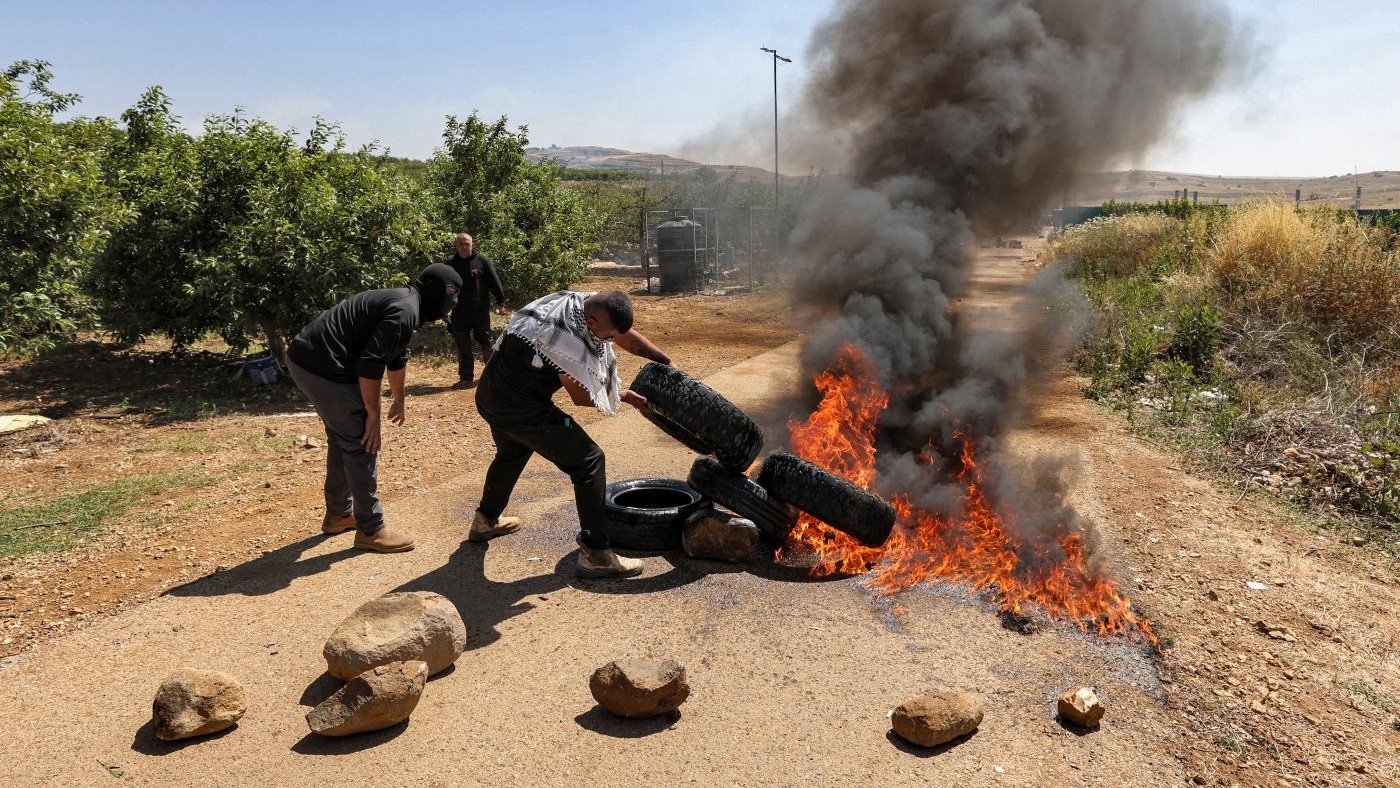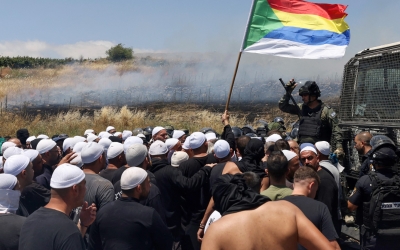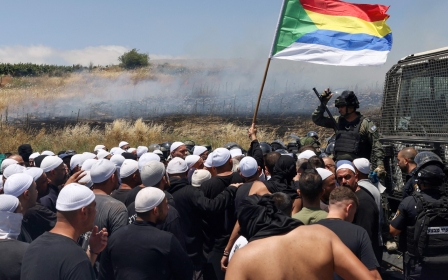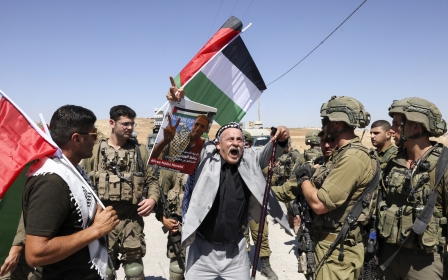How Israel greenwashes its colonisation of the Golan Heights

On early Tuesday morning, Israeli authorities, including hundreds of police officers and more than 100 police vehicles, stormed privately-owned apple and cherry orchards belonging to the Syrian Druze community members in the occupied Golan Heights.
Authorities subsequently blocked off all roads leading to the fields in order to provide the private Israeli company, Energix Renewable Energies Ltd, access and protection to establish a wind turbine farm there.
The far-right Israeli National Security Minister Itamar Ben Gvir is strongly pushing for this wind farm, calling this campaign "Golan Winds" and claiming that the project is necessary for the Israeli economy. He further insisted that the occupied Golan Heights "needs more Israeli governance".
New MEE newsletter: Jerusalem Dispatch
Sign up to get the latest insights and analysis on Israel-Palestine, alongside Turkey Unpacked and other MEE newsletters
As a result, many in the area began demonstrating against the police blockade and wind farm. On 21 June, at 10am local time (8am GMT), Israeli police violently cracked down on protesters using excessive force and live ammunition against them, causing life-threatening injuries to at least five people.
A 'national project'
In 2013, Israeli authorities started planning the development of a wind farm in the occupied Golan Heights, which was declared a "national project" by the Israeli Planning Administration and which allowed the finance minister to confiscate privately-owned lands to develop the area as it wished.
This is the first-ever wind farm to be established on privately-owned lands in Israel
Since then, the area's Syrian citizens have vocally opposed the project on legal and cultural grounds. Private attorneys and nongovernmental organisations submitted on behalf of the local community hundreds of objections to the Israeli planning authorities explaining their opposition.
But the planning authorities did not take their concerns into consideration, approving in 2019 the development of 21 wind turbines on the privately-owned lands of Syrian citizens. It is important to note that this is the first-ever wind farm to be established on privately-owned lands in Israel (of the more than five wind farms).
According to the approved plan, the project will occupy a total area of 3,674 dunams (3,674,000 sqm): 3,644 dunams (3,644,000 sqm) is the area of the wind farm - wide enough to contain turbines up to 200 metres tall - with 20 dunams (20,000 sqm) for roads, eight dunams (8,000 sqm) for infrastructure, and one dunam (1000 sqm) for use by Israeli military and police forces.
Why the opposition?
Occupied during the six-day war in 1967, most of the inhabitants of the Syrian Golan Heights were expelled to the east, into Syria.
After the war, only five villages remained. Since then, the Israeli government took many steps to control the remaining local community and its resources, similar to the policies imposed on Palestinians remaining in 1948: land confiscations, unequal resource division, apartheid and police brutality.
This history made it clear to local Syrian citizens that, even in 2023, a wind farm project is another pretext to control the land as clearly demonstrated in the plans for the project.
The project is planned between the villages of Majdal Shams and Masada, blocking the geographical contiguity between the two villages and making the future expansion of the villages impossible. The already-crowded villages will become even more crowded with no way to expand. For example, Majdal Shams is blocked in all directions: the borders to the east and to the north, a military base and an illegal settlement to the west, and a wind farm to its south.
In addition, during the five decades of Israeli occupation, the local Syrian Druze community relied on agriculture as a main source of income, which allowed some financial independence for the local economy. The wind farm would occupy a wide area of agricultural land, making it near impossible for the farmers to keep working on their lands.
Another reason for this opposition is ecological. It's reported, worldwide nowadays, that wind turbines may cause untold damage to nature and wildlife, especially to bats and birds, while giving very small electric compensation in return. The occupied Golan Heights is home to hundreds of species of birds and bats, some endemic to the area and some endangered.
For these reasons, the local community opposed the project publicly, starting with a wide demonstration in January 2020, and many more since.
'Greenwashing' colonisation
The Israeli company and government advertised the wind farm as a "green" project and as part of Israel's plan to use 30 percent green energy by 2030. The reality, of course, is much different: the project would be far more destructive to nature than helpful.
Since 1967, Israel has been trying to establish more control of the region by building several unlawful settlements
The undeclared reasons for this project are revealed in statements by Israeli leaders such as Ben Gvir who are calling for greater "governance" and, as a result, more occupied land and the expulsion of the locals.
The wind farm is yet another project to exploit the valuable resources of the occupied Golan Heights. Since 1967, Israel has been trying to establish more control of the region by building several unlawful settlements, imposing unequal and unlawful resource management and initiating harmful colonisation projects such as this one.
The connection between the local community and their trees and lands is not only a vital means of survival for a community under occupation but also holds deep cultural and historical significance.
The views expressed in this article belong to the author and do not necessarily reflect the editorial policy of Middle East Eye.
This article is available in French on Middle East Eye French edition.
Middle East Eye delivers independent and unrivalled coverage and analysis of the Middle East, North Africa and beyond. To learn more about republishing this content and the associated fees, please fill out this form. More about MEE can be found here.






